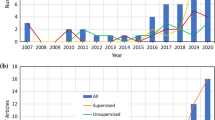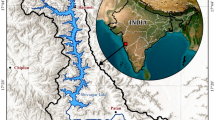Abstract
Landslides are one of the most destructive phenomena in nature and damage both property and lives every year. In this paper, a logistic regression model with datasets developed via a geographic information system and remotely sensed data was used to create a landslide spatial susceptibility map for the Three Gorges Project reservoir region on the Yangtze River in Zigui County. The five causative factors used in the logistic regression model were evaluated in different ways: topographic slope and topographic aspect were derived from a topographical map at 1:50,000 scale; bed rock-slope relationship and lithology were obtained from a geological map at 1:50,000 scale; and fractional vegetation cover (FVC), which represents the reduced frequency of landslides due to the vegetation canopy and ground cover and is also one of the most difficult parameters to estimate over broad geographic areas, was generated using a back propagation neural network (BPNN) method based on CBERS (China–Brazil Earth Resources Satellite) data, the results of which were compared with values measured in the field. The obtained Pearson correlation coefficient (r) was 0.899. Then, the FVC factor and the other four factors were used as the input to a logistic regression model. By integrating the five factor maps in the geographical information system (GIS) via pixel-based computing, the landslide spatial susceptibility map was obtained. The study area was reclassified into four categories of landslide susceptibility: severe, moderate, low, and very low. Approximately 15.0 % of the study area was identified as severe susceptibility, and very low, low, and moderate susceptibility zones covered 21.8, 41.7, and 21.5 % of the area, respectively. These results have an accuracy of 78.90 %. Thus, by using a logistic regression model in a GIS environment, a spatial susceptibility map of landslides can be obtained, and the regions in Zigui County that are susceptible to landslides and need immediate protective and mitigation measures can be identified.











Similar content being viewed by others
References
Aleotti P, Chowdhury R (1999) Landslide hazard assessment: summary review and new perspectives. B Eng Geol Environ 58(1):21–44
Atkinson PM, Massari R (1998) Generalized linear modeling of susceptibility to landsliding in the central Apennines, Italy. Comput Geosci-UK 24(4):373–385
Ayalew L, Yamagishi H (2005) The application of GIS-based logistic regression for landslide susceptibility mapping in the Kakuda-Yahiko mountains, Central Japan. Geomorphology 65(1–2):15–31
Ayalew L, Yamagishi H, Marui H, Kanno T (2005) Landslides in Sado Island of Japan: Part II. GIS-based susceptibility mapping with comparisons of results from two methods and verifications. Eng Geol 81(4):432–445
Bai SB, Wang J, Lü GN, Zhou PG, Hou SS, Xu SN (2009) GIS-based and datadriven bivariate landslide-susceptibility mapping in the Three Gorges Area, China. Pedosphere 19(1):14–20
Cevik K, Topal T (2003) GIS-based landslide susceptibility mapping for a problematic segment of the natural gas pipeline, Hendek (Turkey). Environ Geol 44(8):949–962
Chang KT, Chiang SH, Hsu ML (2007) Modeling typhoon- and earthquake-induced landslides in a mountainous watershed using logistic regression. Geomorphology 89(3–4):335–347
Chau KT, Chan JE (2005) Regional bias of landslide data in generating susceptibility maps using logistic regression Case of Hong Kong Island. Landslides 2(4):280–290
Chen DJ, Cai YJ (1994) Monitoring and prediction of landslides and unstable cliffs in the Three-Gorges reservoir region, People’s Republic of China. In Proceedings of 7th International IAEG Congress, 1383–1389
Chen YR, Chen JY, Hsieh SC, Ni PN (2009) The Application of Remote Sensing Technology to the Interpretation of Land Use for Rainfall-Induced Landslides Based on Genetic Algorithms and Artificial Neural Networks. IEEE J-STARS 2(2):87–95
Chen T, Niu RQ, Li PX, Zhang LP, Du B (2011a) Regional soil erosion risk mapping using RUSLE, GIS, and remote sensing: a case study in Miyun Watershed, North China. Environ Earth Sci 63(3):533–541
Chen T, Niu RQ, Wang Y, Li PX, Zhang LP, Du B (2011b) Assessment of spatial distribution of soil loss over the upper basin of Miyun reservoir in China based on RS and GIS techniques. Environ Monit Assess 179(1–4):605–617
Chung CF, Kojima H, Fabbri AG (2002) Stability analysis of prediction models for landslide hazard mapping. In: Allison RJ (ed) Applied geomorphology: theory and practice. John Wiley and Sons, London, pp 1–19
Cihlar J (1987) A methodology for mapping and monitoring cropland soil erosion. Can J Soil Sci 67(3):433–444
Clark WA, Hosking PL (1986) Statistical methods for geographers. John Wiley and Sons, New York 518 pp
Dai FC, Lee CF (2002) Landslide characteristics and slope instability modeling using GIS Lantau Island, Hong Kong. Geomorphology 42(3–4):213–238
Dai FC, Lee CF, Li J, Xu ZW (2001) Assessment of landslide susceptibility on the natural terrain of Lantau Island, Hong Kong. Environ Geol 40(3):381–391
Dai FC, Lee CF, Ngai YY (2002) Landslide risk assessment and management: an overview. Eng Geol 64(1):65–87
Duman TY, Can T, Gokceoglu C, Nefeslioglu HA, Sonmez H (2006) Application of logistic regression for landslide susceptibility zoning of Cekmece Area, Istanbul, Turkey. Environ Geol 51(2):241–256
Dymond JR, Stephens PR, Newsome PF, Wilde RH (1992) Percent vegetation cover of a degrading rangeland from SPOT. Int J Remote Sens 13(11):1999–2007
Folly A, Bronsveld MC, Clavaux M (1996) A knowledge-based approach for C-factor mapping in Spain using Landsat TM and GIS. Int J Remote Sens 17(12):2401–2415
Gertner G, Wang G, Fang S, Anderson AB (2002) Mapping and uncertainty of predictions based on multiple primary variables from joint co-simulation with Landsat TM image and polynomial regression. Remote Sens Environ 83(3):498–510
Glade T (2003) Landslide occurrence as a response to land use change: a review of evidence from New Zealand. Catena 51(3–4):297–314
Glade T (2005) Linking debris-flow hazard assessments with geomorphology. Geomorphology 66(1–4):189–213
Graetz RD, Pech RR, Davis AW (1988) The assessment and monitoring of sparsely vegetated rangelands using calibrated Landsat data. Int J Remote Sens 9(7):1201–1222
Greco R, Sorriso-Valvo M, Catalano E (2007) Logistic regression analysis in the evaluation of mass movements susceptibility: the Aspromonte case study, Calabria, Italy. Eng Geol 89(1–2):47–66
Guzzetti F, Carrara A, Cardinali M, Reichenbach P (1999) Landslide hazard evaluation: a review of current techniques and their application in a multi-scale study, central Italy. Geomorphology 31(1–4):181–216
Homik K, Stinchcombe M, White H (1989) Multi-layer feed forward networks are universal approximators. Neural Netw 2:359–366
Hosmer DW, Lomeshow S (2000) Applied logistic regression, 2nd edn. Wiley, New York 373
Hubei province geological survey (1965) Geological map of Zigui-Wushan (1:200,000)
Kleinbaum DG (1991) Logistic regression: a self-learning text. Springer, New York
Komac M (2006) A landslide susceptibility model using the analytical hierarchy process method and multivariate statistics in perialpine Slovenia. Geomorphology 74(1–4):17–28
Lan HX, Zhou CH, Wang LJ, Zhang HY, Li RH (2004) Landslide hazard spatial analysis and prediction using GIS in the Xiaojiang watershed, Yunnan, China. Eng Geol 76(1–2):109–128
Lee S (2005) Application of logistic regression model and its validation for landslide susceptibility mapping using GIS and remote sensing data. Int J Remote Sens 26(7):1477–1491
Lee S, Min K (2001) Statistical analysis of landslide susceptibility at Yongin, Korea. Environ Geol 40(9):1095–1113
Lee S, Choi J, Min K (2004) Probabilistic landslide hazard mapping using GIS and remote sensing data at Boun, Korea. Int J Remote Sens 25(11):2037–2052
Li J, Zhou CH (2003) Appropriate Grid Size for Terrain Based Landslide Risk Assessment in Lantau Island, Hong Kong. J Remote Sens 7(2):86–93
Liu JG, Mason PJ, Clerici N, Chen S, Davis A, Miao F, Deng H, Liang L (2004) Landslide hazard assessment in the Three Gorges area of the Yangtze river using ASTER imagery: Zigui-Badong. Geomorphology 61(1–2):171–187
Meentemeyer RK, Moody A (2000) Automated mapping of conformity between topographic and geological surfaces. Comput Geosci-UK 26(7):815–829
Menard S (1995) Applied logistic regression analysis. Sage university series on quantitative applications in the social sciences. Thousand Oaks, 106: 98
Nefeslioglu HA, Duman TY, Durmaz S (2008) Landslide susceptibility mapping for a part of tectonic Kelkit Valley (Eastern Black Sea region of Turkey). Geomorphology 94(3–4):410–418
Ohlmacher CG, Davis CJ (2003) Using multiple logistic regression and GIS technology to predict landslide hazard in northeast Kansas, USA. Eng Geol 69(3–4):331–343
Peng L, Niu RQ, Huang B, Wu XL, Zhao YN, Ye RQ (2014) Landslide susceptibility mapping based on rough set theory and support vector machines: A case of the Three Gorges area, China. Geomorphology 204:287–301
Purevdorj TS, Tateishi R, Ishiyama T, Honda Y (1998) Relationships between percent vegetation cover and vegetation indices. Int J Remote Sens 19(18):3519–3535
Soeters R, van Westen CJ (1996) Slope instability recognition analysis and zonation. In: Turner KT, Schuster RL (eds) Landslides: investigation and mitigation. Transportation Research Board National Research Council, Special Report, Washington, DC, pp 129–177
Stephen JM (1998) An integrated geographic information system approach for modeling the suitability of conifer habitat in an alpine environment. Geomorphology 21(3–4):265–280
Süzen ML (2002) Data driven landslide hazard assessment using geographical information systems and remote sensing. PhD Thesis, Middle East Technical University, Turkey
Süzen ML, Doyuran V (2004) A Comparison of the GIS based landslide susceptibility assessment methods: multivariate versus bivariate. Environ Geol 45(5):665–679
Van Westen CJ, Rengers N, Soeters R (2003) Use of geomorphological information in indirect landslide susceptibility assessment. Nat Hazard 30(3):399–419
Van Westen CJ, Castellanos E, Kuriakose SL (2008) Spatial data for landslide susceptibility, hazard, and vulnerability assessment: an overview. Eng Geol 102(3–4):112–131
Wang HB, Sassa K (2005) Comparative evaluation of landslide susceptibility in Minamata area, Japan. Environ Geol 47(7):956–966
Wang G, Wente S, Gertner GZ, Anderson A (2002) Improvement in mapping vegetation cover factor for the universal soil loss equation by geostatistical methods with landsat thematic mapper images. Int J Remote Sens 23(18):3649–3667
Wen BP, Wang SJ, Wang EZ, Zhang JM (2004) Characteristics of rapid giant landslides in China. Landslides 1(4):247–261
Wu SR, Shi L, Wang RJ, Tan CX, Hu DG, Mei YT, Xu RC (2001) Zonation of the landslide hazards in the forereservoir region of the Three Gorges Project on the Yangtze River. Eng Geol 59(1–2):51–58
Wu SR, Jin YM, Zhang YS, Shi JS, Dong C, Lei WZ, Shi L, Tan CX, Hu DG (2004) Investigations and assessment of the landslide hazards of Fengdu County in the reservoir region of the Three Gorges project on the Yangtze River. Environ Geol 45(4):560–566
Wu XL, Niu RQ, Ren F, Peng L (2013) Landslide susceptibility mapping using rough sets and back-propagation neural networks in the Three Gorges, China. Environ Earth Sci 70:1307–1318
Yesilnacar E, Topal T (2005) Landslide susceptibility mapping: a comparison of logistic regression and neural networks methods in a medium scale study, Hendek region (Turkey). Eng Geol 79(3–4):251–266
Zhou PG (1996) Environmental engineering geological prediction of the new urban site area of Badong City. J Eng Geol 4(4):86–92 (in Chinese)
Zhou CH, Lee CF, Li J, Xu ZW (2002) On the spatial relationship between landslides and causative factors on Lantau Island, Hong Kong. Geomorphology 43(3–4):197–207
Acknowledgments
This research was funded by the CRSRI Open Research Program (CKWV2013221/KY), the Special Fund for Basic Scientific Research of Central Colleges, China University of Geosciences (Wuhan) (CUGL100206), the Natural Science Foundation of Hubei Province (2012FFB06501), the Open Research Fund Program of Key Laboratory of Digital Mapping and Land Information Application Engineering, State Bureau of Surveying and Mapping (GCWD201202), the Open Research Fund of Key Laboratory of Digital Earth, Center for Earth Observation and Digital Earth, Chinese Academy of Sciences (2011LDE003), the National High Technology Research and Development Program of China (2012AA121303), and the National Natural Science Foundation of China (61102128).
Author information
Authors and Affiliations
Corresponding author
Rights and permissions
About this article
Cite this article
Chen, T., Niu, R., Du, B. et al. Landslide spatial susceptibility mapping by using GIS and remote sensing techniques: a case study in Zigui County, the Three Georges reservoir, China. Environ Earth Sci 73, 5571–5583 (2015). https://doi.org/10.1007/s12665-014-3811-7
Received:
Accepted:
Published:
Issue Date:
DOI: https://doi.org/10.1007/s12665-014-3811-7




